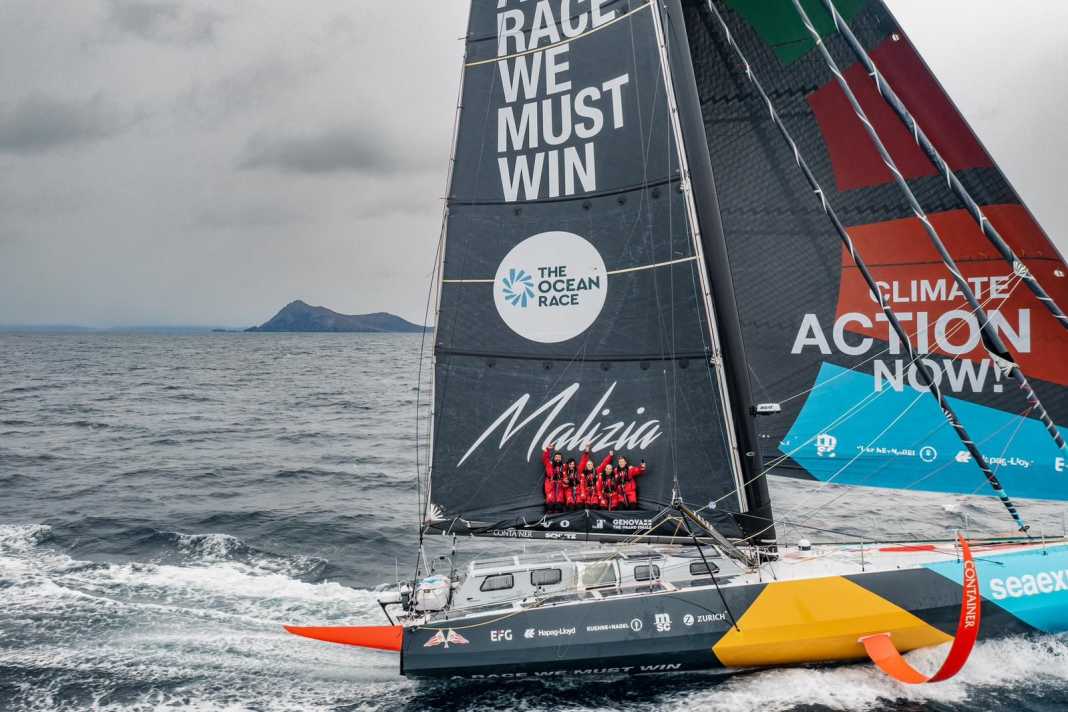





Boris Herrmann's Team Malizia has won the race to the Ocean Race summit of Cape Horn. "Malizia - Seaexplorer" was the first boat in the Ocean Race fleet to pass the legendary Chilean landmark on 27 March at 18:23 German time after 29 days, 4 hours and 8 minutes. The success at the southernmost point of South America was achieved during Boris Herrmann's sixth Cape Horn passage with a lead of around 18 nautical miles over the Swiss team Holcim - which was once again making strong progress. PRB with skipper Kevin Escoffier.
The Roaring Forties Trophy goes to Team Malizia
Boris Herrmann said: "Cape Horn holds many memories for me. Reaching this line first is almost more valuable than winning a stage. Not in terms of points, but in terms of what it means for us. I'm proud of the team and of this boat!" Team Malizia's performance is also rewarded with the Roaring Forties Trophy. This honours the best time of a boat from the Cape of Good Hope to Cape Horn. The "Malizia - Seaexplorer" completed the etmal under the German flag in 27 days, 17 hours and 31 minutes.
Before Boris Herrmann and his crew, sailing greats such as Charles Caudrelier, Ian Walker and Franck Cammas had won this award with their crews. The prize is highly regarded in the professional offshore world. Team Malizia has now travelled a total of around 10,000 nautical miles since the start of the leg to reach Cape Horn. For Will Harris, Rosalin Kuiper, Nico Lunven and Antoine Auriol, it was the first time they had passed the infamous landmark.
Rosalin Kuiper celebrated the Cape Horn Passage differently than expected, but happy and grateful
For the special moment, Rosalin Kuiper briefly gave up her resting position to celebrate the event with her crew mates on deck. The 27-year-old Dutch co-skipper, who is currently recovering from a concussion sustained on 26 March, said: "It's a cinematic hospital where I lie and watch the wonderful passage of Cape Horn. This is not how I imagined the Cape Horn passage. But I couldn't wish for better care either. I'm really grateful to the guys!"
Boris Herrmann praised not only Kuiper's bravery and the entire team, but also his boat, which "proved itself in the Southern Ocean and showed how strong it is". His British co-skipper Will Harris, who will replace Herrmann as skipper again on the fourth leg from Itajaí to the American harbour city of Newport, predicted for the upcoming leg finale: "It will be a close race to Itajaí, Holcim is really pushing and is only just 20 nautical miles behind us. So we have to work hard to finish this leg in first place!"
The last 2,000 or so nautical miles of the "monster stage" are underway
Together, however, Team Malizia and Team Holcim - PRB have built up a large lead over Team Biotherm and 11th Hour Racing, who are around 250 nautical miles behind the leading pair. The successful assault on the summit heralds the final 2,000 nautical miles of what is historically the longest royal stage in the Ocean Race.
The boats leave the South Pacific and turn left into the Atlantic. There, the circumnavigators will sail up the South American east coast to Itajaí in the final phase of leg three. In the Brazilian harbour, the second round of points for the double scored leg will be distributed over a total of almost 15,000 nautical miles. Until then, Team Malizia is in third place in the intermediate classification behind the teams Holcim - PRB and 11th Hour Racing.
The next low is already lurking
The next few hours promise to be exciting, because while the two leading boats sail north-east past Cape Horn and dive back into the Atlantic, a small but strong area of low pressure develops south of the Falkland Islands.
On Tuesday, the front-runners are expected to encounter winds of 30 knots or more from the south in the early morning. This is expected to increase to a very strong 40 knots from the south-south-west by midday. Then the crews on "Malizia - Seaexplorer" and "Holcim - PRB" will probably hook onto the back of the depression and push towards Itajaí before the pressure decreases again.
The first boats are expected in Itajaí on 2 April
Technical advisor Jesse Naimark commented on the timing of the finish in Itajaí: "The current routing indicates an arrival on the morning of 2 April. However, given the lack of consistency in the weather models, I think this is a very optimistic assumption. A later arrival on 2 or 3 April is probably more realistic."
The Ocean Race show on 27 March:
At this point, you will find external content that complements the article. You can display and hide it with a click.

